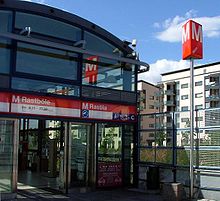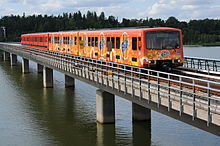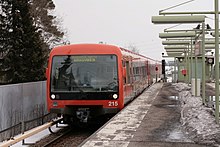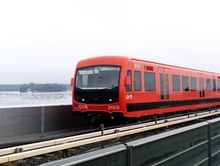Helsinki Metro
| Basic data | |
| Country | Finland |
|---|---|
| city | Helsinki , Espoo |
| Transport network | HSL |
| opening | 1982 |
| Lines | 2 |
| Route length | 35 km |
| Stations | 25th |
| Tunnel stations | 16 |
| Long-distance train stations | 1 |
| use | |
| Shortest cycle | 2.5 min |
| Passengers | 63.5 million per year (2013) |
| vehicles | M100 , M200 |
| operator | HKL |
| Gauge | 1524 mm |
| Power system | 750 V DC power rail |
The Helsinki Metro ( Finnish: Helsingin metro , Swedish: Helsingfors metro ) is the metro of the Finnish capital Helsinki . Opened in 1982, it is the only underground in Finland and also the northernmost underground in the world.
The metro with a length of 35 kilometers connects the center with both the eastern districts and the neighboring city of Espoo to the west . It has two lines (M1 and M2) with 25 stations (as of November 2017), six of which are located in the neighboring city of Espoo to the west. In the east, the otherwise linear route branches into two ends. A little more than 55% of the route runs in the tunnel. A significant extension of the route is the so-called Westmetro , the first construction phase of which was completed in November 2017 and which has since connected Helsinki city center with its western neighbor, Espoo. The second construction phase should be completed by the summer of 2023 and thus expand the metro network to the western end of the neighboring city of Espoo (Kivenlahti district).
Route and operation
The original metro line, officially opened in 1982, connects Helsinki Central Station with Itäkeskus in the east of the city . In a westerly direction, the line was extended in three stages to Kamppi , Ruohonlahti and Matinkylä (and a fourth extension to Kivenlahti is under construction). To the east, the line was extended from Itäkeskus in two different directions: to Mellunmäki and to Vuosaari. The entire western section runs underground to Sörnäinen in the northeastern city center. Then it leaves the tunnel and runs as an elevated train to Kalasatama station . There follows a bridge to the island of Kulosaari . After another bridge that leads back to the mainland, the metro runs at ground level to Itäkeskus, where it branches into a northern section to Mellunmäki and an eastern section to Vuosaari . The latter section initially runs in a tunnel. After Puotila , the metro crosses Vartiokylä Bay on the Vuosaari Bridge, comes to Rastila station and continues at ground level to the Vuosaari terminus. The western route runs from Ruohonlahti over the islands of Lauttasaari and Koivusaari to Keilaniemi , with the tunnel running several times under the Baltic Sea. The deepest route is between Ruoholahti and Lauttasaari at 55 m below the Baltic Sea. The border between Helsinki and the neighboring city of Espoo also runs between Koivusaari and Keilaniemi . The Koivusaari station is unique in the world and is located 30 meters below the seabed of the Baltic Sea. From Keilaniemi, the metro makes a loop in a northerly direction to connect Aalto University , before reaching its current western terminus, Matinkylä , via the Tapiola district and the Urheilupuisto (German: Sportpark), Niittykumpu stations .
The platforms of the stations east of (and including) Ruoholahti are 135 meters long, the newer stations of the Westmetro are only 90 meters long. All stations have handicapped accessible access , some have P + R facilities . The stations are signposted in Finnish and Swedish, the two official languages of Helsinki.
The Helsinki Metro is operated by HKL , the city's transport company, and is part of the transport system organized by the regional transport association HSL . Line M1 runs Monday to Saturday between 5: 09-23: 09 or between 5: 05-23: 05 (first and last departure from Matinkylä and Vuosaari). The M2 line runs Monday to Saturday between 6:00 am and 11:00 pm or 5:20 am to 11:00 pm (first and last departure from Tapiola and Mellunmäki). On Sundays the first M1 leaves Matinkylä at 6:09 am (and 6:15 am from Vuosaari) and the first M2 leaves Mellunmäki at 6:20 am (and 6:37 am from Tapiola). During rush hour , both lines run every 5 minutes, otherwise every seven to eight minutes (every ten minutes on Sundays). From mid-June to the end of July, the metro runs at a lower frequency due to the summer holidays.
Over 200,000 passengers are carried every working day. According to the HKL annual report, the 2013 metro had a total of 63.5 million passengers. The turnover of the Metro division at HKL was 31.4 million euros in the same year, the profit 3.3 million euros.

The two lines (M1 and M2) of the Helsinki Metro (as of November 18, 2017 inclusive) of the western expansion under construction, the station names in Finnish and Swedish and the route lengths
history
In 1958 a planning committee decided that a subway had to be built in the Finnish capital based on the model of other major European cities. It was not until 1969 that the Helsinki City Council decided to build a metro that would better connect the eastern parts of the city with the city center .
Construction work for the subway began in 1971. Nine years later, delivery of the first trains began, so that on June 1, 1982 the first train ran on the route between Hakaniemi and Itäkeskus. On July 1, 1982, an extension of the line between Helsinki Central Station (Rautatientori) and Itäkeskus was released. The commissioning took place in two stages: in the first stage until August 3, the trains only ran during the rush hour of rush hour, then also in the off-peak hours and on the weekends.
On March 1, 1983, the extension to Kamppi was put into operation. The Sörnäinen station has existed since September 1, 1984. In 1981, construction began on the first arm of the line between Itäkeskus and Kontula. This extension went into operation five years later on October 21, 1986. In the same year, construction work began on the extension to include a station as far as Mellunmäki, which went into operation on September 1, 1989.
In order to better develop the new development areas in the Länsisatama district , it was decided to extend the route by one station to the west. A train station was built here at a depth of 30 meters with a 38-meter-wide platform and a huge blue rock ceiling, which is very reminiscent of the stations of the Stockholm Tunnelbana . This station, called Ruoholahti, went into operation on August 16, 1993.
A train station called Kaisaniemi, which was to be built when the metro opened, was added exactly 13 years later, on March 1, 1995, in Kaisaniemi in the city center. In January 2015 this station was to the nearby University of Helsinki at Helsingin yliopisto renamed. Since 2012, an elevator has been leading from the upper level of the train station directly to the new main building of the university library .
Since the area around Vuosaari recorded a strong population growth, this region needed a connection to the metro network. In 1994, construction work began on the 4.2 km extension with three stations for the second arm eastwards from Itäkeskus to Vuosaari. This last extension to date went into operation on August 31, 1998.
In 2006, at the request of HKL, the Helsinki City Council decided to convert the metro to fully automatic, driverless operation by 2011. After numerous delays, technical difficulties and differences of opinion between HKL and the manufacturer of the automatic system, Siemens AG , the project was abandoned for the time being at the end of 2014.
On January 1, 2007, the Kalasatama station between Sörnäinen and Kulosaari was opened. There used to be a freight port in this area. Since it was closed in 2008, a new part of the city has been built here, which thus has its own connection to the metro network. The Kalasatama metro station runs through the REDI shopping center , which was built for the new Kalasatama district.
On November 8, 2009 there was a burst water pipe near the Rautatientori station. As a result, thousands of cubic meters of water penetrated the station, so that the water was 20 centimeters high on the platform. All stops west of the Sörnäinen station were then closed. The next day it was possible to drive to Kaisaniemi station (today Helsingin yliopisto ). During the several months of renovation work, the cost of which was estimated at around five million euros, the trains did not stop at the station, but the two stations behind Kamppi and Ruoholahti were supplied. On February 15, 2010, the renovation was so far completed that Rautatientori was again opened to traffic.
Also in November 2009, work began on an extensive expansion of the network, the so-called Westmetro ( see below ).
vehicles
Overview
The Helsinki Metro has 42 M100 series double multiple units, manufactured by the Finnish companies Valmet and Strömberg, and twelve M200 series double multiple units, produced by the Canadian-German rail vehicle manufacturer Bombardier Transportation at the Ammendorf (DWA) plant. Twenty units of the third series, M300, were built by the Spanish manufacturer CAF and delivered from 2015. In contrast to the previous series, a unit of the M300 series consists of four permanently coupled vehicles that can be walked through and is not equipped for multiple traction. All series use a side-mounted busbar with a voltage of 750 volts direct current , which is coated from below, for power consumption . All metro vehicles in Helsinki run - like the Finnish railways - on tracks with 1,524 millimeters wide gauge . Three double railcars (six wagons) form a unit, meaning that the Helsinki Metro has 18 units of series 100 or 200 and twenty four-part trains of series 300 available. Since the western expansion went into operation in 2018, only short trains with a length of two double railcars (four cars) have been used, whereas in the past, the maximum number of passengers could be increased by 50% at peak times by using three double railcars. All vehicle types can be mechanically coupled to one another (for towing), but mixed multiple units are not possible.
| model series | Manufacturer | delivery | number | dare | length | Seats | Passengers | comment |
|---|---|---|---|---|---|---|---|---|
| M100 | Valmet / Strömberg | 1977-1984 | 42 | 2 | 44.2 m | 130 | 287 | |
| M200 | Bombardier / Traxis | 2000-2001 | 12 | 2 | 124 | 287 | Passage between the cars is possible | |
| M300 | CAF | 2015 - | 20th | 4th | 90 m | 228 | 572 | Passage between the cars is possible |
| 2022 - | 5 |
M100 series
At the time of the decision to build a subway, the Finnish companies Valmet and Strömberg were developing the first trains for the Helsinki Metro. Valmet made the mechanical parts and Strömberg made the electrical equipment. Above all, the vehicles had to meet the winter conditions of the Finnish capital. The cars originally delivered between 1977 and 1984 were modernized between 2004 and 2009 in order to extend their service life by a further twenty years. In 2013 there were a total of 42 double railcars that can travel up to 100 km / h, have 130 seats and carry 287 passengers. The smallest unit (a double railcar with two cars) is 44.2 meters long, 3.2 meters wide and 3.7 meters high. You can circulate in a formation of up to three units. This series of cars is designated with the identifier M100.
M200 series
In 2000 and 2001, Bombardier Transportation delivered four full trains with a total of twelve double multiple units of a new series with the designation M200, which were manufactured in the Ammendorf plant (formerly Deutsche Waggonbau AG). The electrical equipment for this was supplied by the Traxis company. In terms of dimensions, this series differs only slightly from the M100 series, but looks much more modern on the outside. The trains, like their predecessors, have three doors on each side of the car. With this type there is a passage between the two cars of a double railcar. In addition, they are equipped with an information system that presents the next station not only by announcement but also by display. The M100 series was later equipped with the same displays. A double multiple unit from the M200 series has 124 seats and can accommodate 287 passengers.
M300 series
The opening of the Westmetro (see below) will require a significant expansion of the vehicle fleet. In February 2013, HKL therefore ordered 20 new short trains (equivalent to 40 double multiple units) from the Spanish manufacturer CAF Construcciones y Auxiliar de Ferrocarriles . Deliveries of the trains began in March 2015, and passenger transport began in September 2016. The outward appearance of the new trains is similar to the M200 series. These are connected four-part units with a length of 90 meters, 228 seats and standing room for 572. Passage inside the train from one end of the train to the other is possible. The trains are air-conditioned. The driver's compartments can be replaced by eight additional passenger seats after a possible automation of the metro. In one unit, the two end cars and one middle car are powered on all axles, the second middle car is a non-powered sidecar.
In February 2020, the HKL transport company awarded CAF an order worth € 39.9 million for the delivery of five further four-part M300 metro trains and the provision of spare parts over their expected service life of 40 years. The additional M300 trains are to be delivered from the CAF plant in Zaragoza in 2022. This will increase capacity to cope with the forecast increase in passenger numbers when the second phase of the Länsimetro extension from Matinkylä to Kivenlahti opens in the early 2020s.
Company workshop
The trains are serviced in the workshop in Roihupelto (between the Siilitie and Itäkeskus stations). Two tracks lead from the line to the depot, which can wait for six trains at the same time in the workshop hall. It is also possible to repair eight trains at the same time. 44 trains can be parked in the storage hall next to the workshop. From the depot there was a non-electrified, single-track operating line via the Viikki and Pihlajisto districts to Oulunkylä until 2012 , via which there was a connection to the national railway network for the transport of train units if necessary. It has been replaced by a new operating line that runs from the Vuosaari station to the Vuosaari port, where it is connected to the railway network.
A second, underground depot is to be built in Sammalvuori at the western end of the so-called Westmetro, between the planned stations Espoonlahti and Kivenlahti.
New route projects
West metro
Work is currently underway to extend the current metro line in a westerly direction to Espoo . Work on the first construction phase lasted from November 2009 to November 2017. This section, which opened on November 18, 2017, comprises eight new stations, two of which are in the Helsinki area and six in Espoo, with the Matinkylä terminus. The length of this section is 13.9 km. In December 2014, work began on the second, 7 km long construction phase. This includes another five stations and leads to Kivenlahti on the western edge of Espoo. In contrast to the eastern outskirts of Helsinki, where the metro line runs mainly at ground level, this extension, known as the "Westmetro" (Finnish. Länsimetro ), is completely underground. Their construction was unsafe for a long time. The city of Helsinki had been pushing for the west metro to be built for decades, but the implementation of the plans could not begin for a long time due to the resistance of the city of Espoo. It was not until September 2006 that Espoo City Council gave its approval to the construction of the metro, subject to numerous conditions.
As a result of a controversial decision from the start, the new stations are only 90 meters long, not 135 meters like the previous stations. Therefore, only short trains are used on the entire metro network (also on the older sections). The resulting loss of capacity was compensated for by increasing the clock frequency to 2.5 minutes. This increase in clock frequency was planned as part of the automation project (see above) that has since been abandoned, but the new interlocking made it possible without automation. However, the Westmetro was already working close to its maximum capacity when it went into operation.
The first construction phase was originally supposed to be completed in autumn 2014. Its construction costs were estimated at 713.6 million euros in the planning phase. In February 2014 it was estimated that operations could not start until autumn 2016 and that the cost would be just under a billion. Two months before the planned opening of the first construction phase on August 15, 2016, it was announced that commissioning would not take place until January 2017. After the commissioning was postponed to autumn 2017, the opening of the first construction phase for passenger traffic took place on November 18, 2017.
The construction costs were revised upwards several times in the course of the project and probably amounted to 1.186 billion euros for the first construction phase. The costs for the second construction phase are estimated at 1.158 billion euros. These will be shared between the cities on whose territory the metro will move. Since most of the route is in the Espoos area, the city of Espoo will cover 80 percent of the construction costs. In addition, the Finnish state supported the construction of the Westmetro with 200 million euros.
Other Projects
Extensions
The current line is to be extended to the east. It is planned to extend the section leading to Vuosaari by one station because of the new port opened there at the end of 2008. The new station at the port would be called Vuosaaren satama .
Since parts of the eastern neighboring municipality of Sipoo were added to the city of Helsinki at the beginning of 2009 , an extension of the section leading to Mellunmäki has been discussed.
Second line
A second route, which would cross the current route at Kamppi, has been seriously planned for a long time. In a northerly direction, it should initially lead from Kamppi to Pasila train station . In between are the stations Töölöntori, Stadion and Meilahti. In the end, this line should continue from Pasila in two arms, on the one hand north to Helsinki-Vantaa airport , on the other hand in a north-east direction to the Viikki district.
Seen from Kamppi in the other direction, the train should be able to travel via the planned stations Esplanadi and Katajanokka as well as under the sea to the island of Laajasalo, possibly further to the island of Santahamina. As early as the 1970s, a separate cavity was excavated below what is now Kamppi station, which is intended to accommodate the platform of the crossing line. In 2008 the city administration decided to dig a cavity for the future station in Pasila. This offered itself because of other construction work to be done on the same site. The construction of the rest of the line is not expected until after 2020, and the construction of the tunnel leading to Laajasalo in particular is uncertain.
literature
- Robert Schwandl: Subways in Scandinavia - Stockholm, Oslo, Helsinki, København. Robert Schwandl Verlag, Berlin 2004, ISBN 3-936573-04-2 .
- Rapid Transit Office of the City of Helsinki / Helsinki Metro Office: The Helsinki Metro - The Helsinki Metro 1982 . Helsinki 1983, ISBN 951-771-377-0 .
- WJ Hinkel, K. Driver, G. Valenta, H. Liebsch: yesterday-today-tomorrow - subways from 1863 to 2010. Schmid Verlag, Vienna 2004, ISBN 3-900607-44-3 , chapter Helsinki .
Web links
- HKL (operator of Helsinki metro)
- Länsimetro - Official website of Westmetro (Finnish, Swedish, English)
- Finnish Tramway Society Metro pages
- Metro Helsinki at urbanrail.net (English)
- Pictures of the Helsinki metro
Individual evidence
- ↑ Metroliikenne ja ympäristö ( Memento of March 4, 2016 in the Internet Archive ) (PDF; 1,056 kB, Finnish, p. 2) accessed on June 1, 2017
- ↑ a b Tervetuloa metroon! In: Helsingin Sanomat , November 18, 2017, pp. A8-A9
- ↑ Reitit yes aikataulut . In: HSL . Retrieved April 18, 2019.
- ↑ HKL Annual Report 2013 ( Memento from May 12, 2015 in the Internet Archive ) (PDF, English, p. 8)
- ↑ Kaisaniemi Metro Station to be renamed University of Helsinki HSL December 31, 2014.
- ↑ a b HKL on irtisanonut automaattimetron sopimuksen Siemens in kanssa Yleisradio , December 18, 2014.
- ↑ "Liikenne." Uutta Helsinkiä, March 13, 2013. https://www.uuttahelsinkia.fi/fi/kalasatama/liikenne .
- ^ Metro station re-opens after flood repair , International Edition, February 15, 2010.
- ↑ a b data sheet series M300. (No longer available online.) Finnish Tramway Society, archived from the original on August 27, 2017 ; accessed on August 31, 2017 . Info: The archive link was inserted automatically and has not yet been checked. Please check the original and archive link according to the instructions and then remove this notice.
- ↑ a b HKL: Helsingin metrojunat ( Memento from June 30, 2013 in the Internet Archive ) / Helsinki's metro trains ( Memento from May 29, 2013 in the Internet Archive )
- ↑ Information on the 200 series, Bombardier Transportation
- ↑ HKL yes CAF sopimukseen metrojunahankinnasta ( Memento from June 24, 2013 in the Internet Archive ) HKL, February 6, 2013.
- ↑ 2020-02-06T11: 31: 00 + 00: 00: Helsinki metro fleet expansion and cab modifications agreed. Retrieved February 7, 2020 .
- ↑ Sammalvuori depot
- ↑ a b Länsimetron aloituspaukku räjähti Ruoholahdessa ( Memento from November 27, 2009 in the Internet Archive ) Yleisradio November 24, 2009.
- ↑ Metron Rakentaminen Matinkylästä Kivenlahteen alkoi Yleisradio , December 11, 2014.
- ↑ Siemens: Länsimetron valmistumisen uusikin aikataulu on Tiukka Helsingin Sanomat, February 11, 2014.
- ↑ Press release of the City of Espoo of June 30, 2016 on the new expected opening date.Retrieved on July 27, 2016.
- ↑ Länsimetron hallitus: ”Kaikki on valmista” - HKL: n johtaja: ”Liittyy epävarmuustekijöitä” . In: Ilta-Sanomat . August 24, 2017 ( is.fi [accessed September 5, 2017]).
- ↑ Metro services from November 18, 2017 . In: HSL . ( hsl.fi [accessed December 6, 2017]).
- ↑ Malmberg, Lari; Oksanen, Kimmo; Salomaa, Marja: Länsimetron toimitusjohtaja sai potkut . In: Helsingin Sanomat . November 14, 2016 ( hs.fi [accessed December 4, 2016]).
- ↑ Varmavuori, Marjaana: Länsimetron kakkosvaiheen suunnitelma julki . In: Helsingin Sanomat . March 1, 2018 ( hs.fi [accessed March 1, 2018]).
- ↑ Länsimetron kustannukset lankeavat espoolaisten ja helsinkiläisten veronmaksajien maksettavaksi Yleisradio , July 1, 2016, accessed on July 27, 2016.
- ↑ Spökstations väntar på tåg. In: Hufvudstadsbladet . July 28, 2007, accessed December 1, 2015 .
- ↑ Pasilaan rakennetaan metroasema vaikka metrosta ei ole vielä tietoa Helsingin Sanomat , November 18, 2008.













